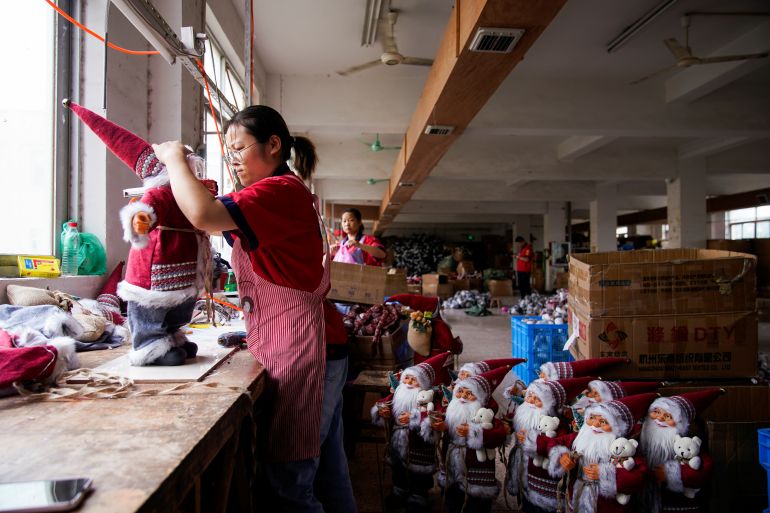China’s factories crank up output, but jobs, debt remain concerns
Official factory data show output rose to highest level in more than three years in November on strong domestic demand.

China’s factory activity expanded at the fastest pace in more than three years in November, while growth in the services sector also hit a multi-year high, as the country’s economic recovery from the coronavirus pandemic stepped up.
Upbeat data released on Monday suggest the world’s second-largest economy is on track to become the first to completely shake off the drag from widespread industry shutdowns, with recent production data showing manufacturing now at pre-pandemic levels.
Keep reading
list of 4 itemsParty over? China trade rift threatens Australian winemakers
China slaps 200% import tax on Australian wine amid tensions
Old and young, Chinese vent anger at move to raise retirement age
But companies are still not expanding their payrolls, the figures show, and some analysts point to rising debt levels among state-owned firms as another possible headwind for the economy.
China’s official manufacturing Purchasing Manager’s Index (PMI) rose to 52.1 in November from 51.4 in October, data from the National Bureau of Statistics showed. It was the highest PMI reading since September 2017 and remained above the 50-point mark that separates growth from contraction on a monthly basis. It was also higher than the 51.5 median forecast in a Reuters poll of analysts.
“The latest official PMI surveys show that the pace of economic growth picked up in November on the back of a broad-based improvement in both services and manufacturing,” Julian Evans-Pritchard, senior China economist at research firm Capital Economics, said in a note sent to Al Jazeera.
China’s blue-chip share index hit a 5-and-a-half-year high following the data release.
Acceleration
The robust headline PMI points to solid fourth-quarter growth, which analysts at Nomura expect to quicken to 5.7 percent compared with the same period last year, from 4.9 percent in the third quarter, an impressive turnaround from the deep contraction earlier this year.
![China official PMI November chart [Bloomberg]](/wp-content/uploads/2020/11/366350717.jpg?w=770&resize=770%2C433)
The economy is expected to expand by about 2 percent for the full year, the weakest in more than 30 years but still much stronger than other major economies that are struggling to bring their coronavirus outbreaks under control.
The official PMI, which largely focuses on big and state-owned firms, showed the sub-index for new export orders stood at 51.5 in November, improving from 51.0 a month earlier. That bodes well for the export sector, which has benefitted from strong foreign demand for medical supplies and electronics products.
Also helping activity in November were aggressive e-commerce shopping promotions, which unleashed solid consumer demand and bolstered confidence for small and medium firms.
But a surging yuan and further lockdowns in many of its key trading partners could pressure Chinese exports, which have been surprisingly resilient so far.
More companies have reported the impact from currency fluctuations, compared with a month ago, said Zhao Qinghe, senior statistician at the NBS.
“Some firms have flagged that as the yuan continues to rise, corporate profits are under pressure and export orders are declining,” said Zhao.
He added that the recovery across the manufacturing industry remained uneven. For example, the PMI for the textile industry has stayed below the 50-point threshold, pointing to weak business activity.
Consumer comeback
In the services sector, activity expanded for the ninth straight month. The official non-manufacturing Purchasing Managers’ Index rose to 56.4, the fastest since June 2012 and up from 56.2 in October, as consumer confidence gathered pace amid few COVID-19 infections.
Railway and air transportation, telecommunication and satellite transmission services and the financial industry were among the best-performing sectors in November.
A sub-index for construction activity stood at 60.5 in November, improving from 59.8 in October, as China steps up infrastructure spending to revive its economy.
Monday’s data also showed that the labour market is still facing strains. Services firms reduced payrolls at a faster clip in November, while factories slashed staff for the seventh straight month, although at a slower pace.
“The continued recovery reduces the need for further monetary easing, but any shift to tightening is also unlikely given continued labour market pressure,” said Erin Xin, Greater China economist at HSBC.
Another factor that could prove problematic for China is rising levels of debt among regional governments and state-owned enterprises (SOEs).
“The recent wave of SOE debt defaults has contradicted the overall data improvement, including the latest PMI,” wrote Daiwa Capital Markets economists Kevin Lai and Eileen Lin in a research note sent to Al Jazeera.
“Many of these companies should have benefited from a nascent recovery since the economy reopened. However, most of these companies are owned and controlled by local governments,” they said.
“They have been allowed to raise more funds from the bond market and run bigger fiscal deficits when the pandemic began to hit the local economy. Hence, when domestic demand indicators turn better, it is usually a result of more debt-driven stimulus being injected into various industrial sectors.”